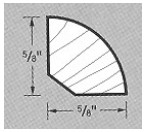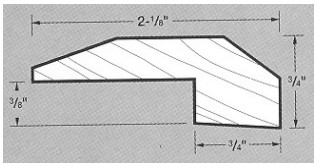The Various Types of Trim, Mouldings, Nosing and Their Application
At Royal Oak, we will manufacture, supply and install nosing, but we do not manufacture, supply and or install trim, transitions or reducers. Here are the examples of the differences and a better understanding of various types of trim, mouldings, nosing and its application.

Quarter Round and Wall Base Trim (Royal Oak does not provide):
Quarter round and wall base trim are used to the cover the expansion gap between the flooring and the wall.
End Cap or Square Nose Transition (Royal does not provide):
 Square nose transition is also referred to as end mold, end cap, universal edge or baby threshold. This transition is used to transition from a wood or laminate floor to another type of flooring. It is also used against sliding glass door tracks and metal thresholds of exteriors doors, or to join another floor or surface that is higher than the new floor.
Square nose transition is also referred to as end mold, end cap, universal edge or baby threshold. This transition is used to transition from a wood or laminate floor to another type of flooring. It is also used against sliding glass door tracks and metal thresholds of exteriors doors, or to join another floor or surface that is higher than the new floor.

Reducer Strip (Royal does not provide):
A reduce strip is used when transitioning from a wood or laminate floor, to a lower flooring surface, such as a vinyl floor or painted concrete. Another application for the reducer strip is at a sliding glass door, but only if there is no lip or track protruding above the floor.
T-Mold (Royal does not provide):
 T-molding is used to transition from one floor to another when both are at the same finished height. Another example would be where a new laminate or wood floor joined a ceramic tile floor at the same finished height. The purpose of the extended lips is to cover the expansion space without interfering with the function of the space.
T-molding is used to transition from one floor to another when both are at the same finished height. Another example would be where a new laminate or wood floor joined a ceramic tile floor at the same finished height. The purpose of the extended lips is to cover the expansion space without interfering with the function of the space.
Stair Nosing (Royal will manufacture, supply and install):
It is the horizontal, protruding edge of a stair where most foot traffic frequently occurs. Stair nose is used to trim out the edges of the step-down and staircases covered by laminate or wood flooring. Here are 2 examples:




